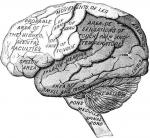Cerebral Localization.
That man is the most wonderful piece of mechanism in the universe is conceded by all, and each individual part of this composite being must be thoroughly understood by the medical man, if he is to successfully combat the countless functional and organic lesions that daily beset him.
Life is too short, however, for any one man to master all, or even one important part, of every organ. The medical man of the present day has come to understand this as never before, and has divided his labor by selecting some special part for his life-work. Thus we have the specialist on the circulatory system, the respiratory apparatus, the blood, the skin, the eye, the ear, etc.
What is true of the body at large, is especially true of the brain. The study of this composite organ during the last few years has completely revolutionized the theories of this most wonderful organ, the seat of all the higher mental faculties and the director of all the voluntary motions, which distinguishes man from the entire animal world, and places him in a class by himself.
Much has been learned by vivisection on the lower animals, much by accidents and disease of the brain, and much by the pathologist after death; and from the combined experience of the experimentalist, the physiologist, the pathologist, and the clinician,, the architecture and physiology of the brain has made wonderful advances during the last few years.
The study of the brain is a life-study, and in a work on general practice we can but glance at some of the more important lesions, referring the student for further research to special works upon the brain and nervous system. The general practitioner, however, should understand that the brain must be regarded as a composite organ; that each of its parts has some special function that, to some extent, is independent of its fellow-member.
Thus one part, the medulla oblongata, is essential to vital processes, and the slightest injury, even the thrust of a needle, may result in instant death. Another presides over the various movements of the body, and an injury or disease of this part is followed by paralysis of motion; or it may be that the part that presides over sight, or hearing, or taste, or smell is involved, and the function of the eye, or the ear, or taste, or smell is impaired.
Through the researches of Meynert, Luciani, Charcot, Exner, Nothnagle, Ferrier, Flechsig, Wernicke, Munk, and others, the topography of the brain has been so well outlined that the skilled neurologist of to-day can, by carefully noting the symptoms, locate the diseased condition, and not infrequently cure the disease by removing the cause by operative measures. Thus epilepsy has been overcome, when due to pressure upon some part, by removing the source of irritation. Aphasia, or loss of. speech, has been restored by opening and draining an abscess of the third frontal convolution, the seat of speech centers.
The topography of the cerebral cortex is now so well understood that it is possible to map, with great accuracy, the various regions in which motor impulses originate.
The cerebrum is divided into two hemispheres, each of which consists of five lobes,—the frontal, the parietal, the occipital, the temporo-sphenoidal, and the central, or island of Reil. These are divided or separated by three fissures,—the fissure of Rolando, the fissure of Sylvias, and the parieto-occipital fissure.
The frontal lobe consists of three convolutions,—the superior frontal, the middle frontal, the inferior frontal, and the ascending frontal.
The parietal lobe consists of three convolutions,—the ascending parietal (posterior central) convolution, the superior parietal, and the inferior parietal.
The occipital lobe consists of three convolutions,—the superior, the middle, and the inferior convolutions.
The temporo-sphenoidal lobe consists of three convolutions,—the superior, the middle, and the inferior convolutions.
The central lobe, or island of Reil, consists of six.
 "The surface of the brain is the seat of all conscious mental action. It is the receptable of all the impressions made upon the organs of sight, smell, taste, hearing', and the tactile organs of the skin. Here, and only here, do such impressions become transformed into conscious appreciation of external objects."
"The surface of the brain is the seat of all conscious mental action. It is the receptable of all the impressions made upon the organs of sight, smell, taste, hearing', and the tactile organs of the skin. Here, and only here, do such impressions become transformed into conscious appreciation of external objects."
 By examining diagrams, one gets a clearer idea of the areas that control certain functions. Thus the higher mental faculties, reason, will, judgment, etc., are the result of cell activity in the frontal lobe, while the power of speech resides in the inferior frontal convolution of the same lobe. A part of the frontal and parietal (central convolution) presides over all motor acts of the limbs and body. The upper parts control the legs chiefly, the middle part governs the hand and arm, while the lower part presides over the complex movements of the tongue and lips necessary to speech.
By examining diagrams, one gets a clearer idea of the areas that control certain functions. Thus the higher mental faculties, reason, will, judgment, etc., are the result of cell activity in the frontal lobe, while the power of speech resides in the inferior frontal convolution of the same lobe. A part of the frontal and parietal (central convolution) presides over all motor acts of the limbs and body. The upper parts control the legs chiefly, the middle part governs the hand and arm, while the lower part presides over the complex movements of the tongue and lips necessary to speech.
The parietal lobes, not occupied by special centers of motion, are centers of touch, pain, and temperature.
The temporal lobes preside over sounds, odors, and taste.
The occipital lobes preside over sight.
The Eclectic Practice of Medicine, 1907, was written by Rolla L. Thomas, M. S., M. D.

